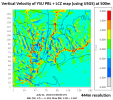I have been running WRF at urban scale and have recently added a local climate zone map to my innermost domain. When looking at the output from test runs I have come across some issues with the vegetation parameters for the urban classes, the most glaring of which being that all the values are exactly the same for every urban class (Leaf area index = 4.29 m^2/m^2, shade fraction = 27-56%, vegetation fraction= 55.5%). They were most likely drawn from LANDUSE.TBL as it has values for the LCZ classes that are exactly the same for every category (which I could try changing myself to make more sense, but I can't tell what most of those categories actually are or what values would be reasonable). The other reason I think this is the case is because I was initially using NLCD land use data and it doesn't have categories for LCZ classes so the vegetation categories output by those runs are negative indicating missing data.
Logically, the vegetation fraction for the urban LCZ classes should be 1 - FRC_URB, a variable that can be found in URBPARM_LCZ.TBL. How do I go about fixing the values in the tables to produce reasonable output that matches 1-FRC_URB?
Logically, the vegetation fraction for the urban LCZ classes should be 1 - FRC_URB, a variable that can be found in URBPARM_LCZ.TBL. How do I go about fixing the values in the tables to produce reasonable output that matches 1-FRC_URB?


